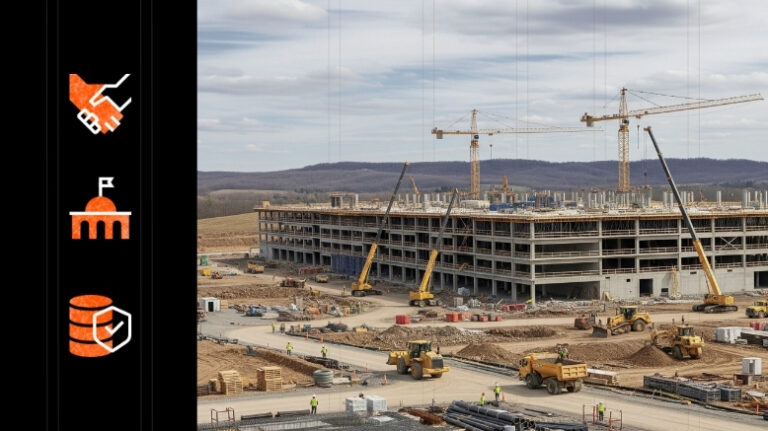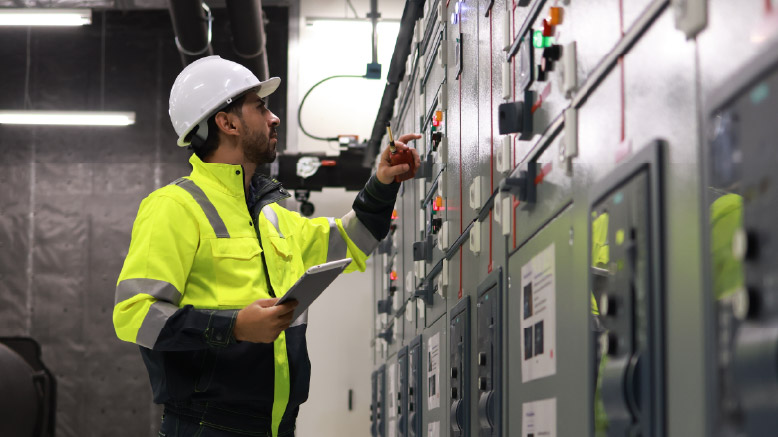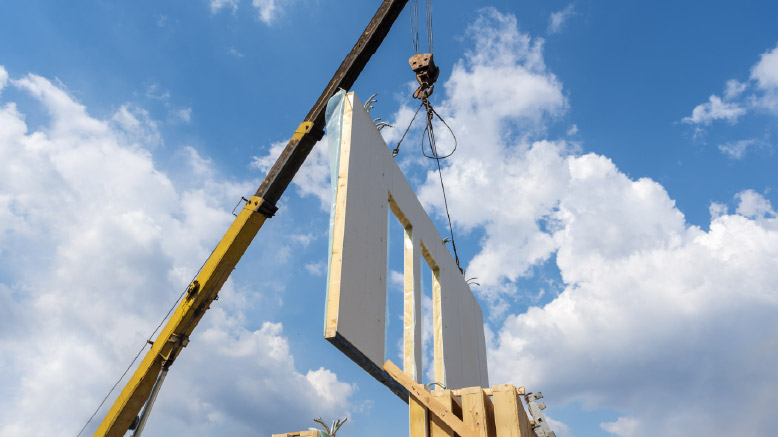— 5 min read
Power, Politics & Permits: The External Forces Shaping Data Center Development


Last Updated Sep 23, 2025

Scott Bornman
Principal, Operational Excellence
15 articles
Scott Bornman is a managing strategic product consultant at Procore Technologies. Scott began his long construction career after a successful 8+ years in the U.S. Army, where he selected to be U.S. Army Recruiter following Desert Shield/Desert Storm. Scott has had many roles in the construction field since then, working his way from a project superintendent, to an owner's rep, to a senior project manager and even Vice President of Construction at Bognet Construction and Director of Construction at Plaza Construction before joining the team at Procore.

Marlissa Collier
33 articles
Marlissa Collier is a journalist whose work focuses on the intersections of business, technology, policy and culture. Her work has been featured in digital and print formats with publications such as the Dallas Weekly, XO Necole, NBCU Comcast, the Dallas Nomad, CNBC, Word in Black and Dallas Free Press. Marlissa holds an undergraduate degree in Construction Engineering from California State University, Long Beach and an MBA from Southern Methodist University’s Cox School of Business.
Last Updated Sep 23, 2025

As the need for digital infrastructure accelerates, data centers have become essential to powering the world’s digital economy. Yet, behind every hyperscale facility is a complex web of external forces that determine where, how and even if a data center gets built. Proper energy availability along with local regulatory environments and community sentiment are becoming just as important as budgets and blueprints.
In a sector once dominated by engineering and construction timelines, external pressures are now shaping the very feasibility of projects. This shift requires construction leaders and data center owners to think beyond the site and further toward grids, governance and goodwill.
Table of contents
The Power Predicament
Perhaps the most urgent constraint facing data center developers today is energy, or, how this massive structure will be powered. These facilities are incredible consumers of power, requiring hundreds of megawatts to operate efficiently.
For example, in Northern Virginia — known as “Data Center Alley” — demand is so high that Dominion Energy had to pause new connections in 2022 due to grid strain.
As such, elsewhere, new approaches are emerging. Companies are actively exploring co-locating data centers near renewable sources like solar and wind farms, or leveraging Battery Energy Storage Systems (BESS) to manage peak loads. In Texas, the startup Last Energy is pushing the envelope by proposing the use of micro nuclear reactors to power data centers off-grid—highlighting how unconventional energy models are quickly becoming part of the mainstream discussion.
Regulatory requirements for building a nuclear plant are immense; it can take eight to ten years just to get approval. This timeline is simply unfeasible for the rapid pace of data center development.

Scott Bornman
Principal, Operational Excellence
Procore Technologies
For data center builders, this means engaging earlier in utility planning discussions so scalable and redundant energy strategies are in place long before groundbreaking. It also means understanding local energy policy and incentives, which can dramatically impact site viability.
Local Politics, Global Demand
While the data center boom is global, approvals and regulations can be hyper-local.
Increasingly, city councils and county boards are pushing back against new developments — especially when concerns over noise, traffic, aesthetics and limited job creation outweigh perceived benefits.
In the Netherlands, the municipality of Zeewolde rejected a proposed Meta data center in 2022 due to public opposition, marking a turning point in how host communities view these projects. Similarly, parts of Ireland and the UK have introduced moratoriums or tougher regulations on data centers to protect energy availability for households and essential services. The message is clear: community and political buy-in cannot be an afterthought.
My primary concern with deregulation for data centers is whether we can build enough momentum — getting projects off the ground and constructed — to ensure they won't be halted when political and regulatory tides inevitably shift.
Scott Bornman
Principal, Operational Excellence
Procore Technologies
Builders must now work in tandem with local governments and planning boards, often taking on roles typically reserved for community engagement or government affairs teams. Transparent communication, community investment and early outreach are becoming key elements of a successful build strategy.
Zoning, Permitting & the Speed Bump of Red Tape
Data center construction is racing ahead — but permitting processes often lag behind. In some U.S. states, it can take 12–18 months just to secure approvals, even for shovel-ready sites. Add in environmental impact studies, utility service negotiations and public hearings, and a project’s start date can quickly begin to slide.
This dynamic is prompting a new wave of lobbying from industry groups, urging lawmakers to modernize permitting pathways. In Virginia, for instance, local governments are exploring the creation of fast-track data center zones, complete with pre-approved design criteria and infrastructure incentives.
Average constructors struggle to fathom or build what's being demanded. We're asking them to build larger, faster and with higher quality than ever before, often with design documents that are 'iffy at best.'
Scott Bornman
Principal, Operational Excellence
Procore Technologies
Internationally, Singapore lifted its data center moratorium after instituting a new sustainability framework, which prioritizes energy-efficient builds. This move is seen as a model for balancing development with environmental oversight.
For contractors, developers and owners alike, navigating these evolving policies requires strong cross-functional coordination — legal, environmental, design and operations must align early to avoid delays.
The Push for Sustainability & Energy Reciprocity
In an effort to shift public perception and improve community relations, some developers are designing projects that give back. This includes plans to recycle heat generated from servers into local district heating systems or to return surplus energy to local grids during off-peak periods.
If we're building a data center, my strategy would be to install an oversized microreactor, generating 50% more power than needed and feeding the surplus back to the grid. This makes us good neighbors and eases the approval process.
Scott Bornman
Principal, Operational Excellence
Procore Technologies
Companies like Amazon are committing to matching 100% of their energy use with carbon-free sources, further raising the bar for project sustainability. These targets also drive new expectations around material sourcing, water usage and carbon accounting throughout the construction lifecycle.
Builders are now being asked not only to execute, but to innovate — with energy conservation and long-term operational impact top of mind.
Free AI in Construction Course with Hugh Seaton
Start learning today with industry expert Hugh Seaton and discover how AI can boost efficiency, reduce risk, and transform your projects.

Where Technology Meets Diplomacy
Managing these external pressures takes more than field expertise. Construction leaders must become fluent in stakeholder engagement and public relations. Projects are being won and lost in boardrooms and town halls, not just on bid sheets.
This complexity is driving greater reliance on data-driven decision-making. Integrated construction platforms with robust Building Information Modeling (BIM), document tracking and AI analytics allow teams to scenario-plan, forecast bottlenecks and keep stakeholders aligned.
BIM software can be particularly helpful in mapping out environmental impact models, energy simulations and permitting timelines — tools that allow developers to go into meetings with data rather than just proposals. As regulations tighten and community demands rise, digital tools will play an increasingly large role in building trust and transparency.
The data center boom is not just a construction story — it’s a tale of negotiation, adaptation and reinvention. As these facilities become more central to the global economy, the forces shaping their development extend well beyond the jobsite.
From strained utility grids to zoning commissions, successful execution increasingly hinges on how well builders can navigate external dynamics. With the right strategies — and the right technologies — developers can not only deliver: They can lead in this high-stakes era of digital infrastructure.
Was this article helpful?
Thank you for your submission.
0%
0%
You voted that this article was . Was this a mistake? If so, change your vote
Scroll less, learn more about construction.
Subscribe to The Blueprint, Procore’s construction newsletter, to get content from industry experts delivered straight to your inbox.
By clicking this button, you agree to our Privacy Notice and Terms of Service.
Thank you!
You’re signed up to receive The Blueprint newsletter from Procore. You can unsubscribe at any time.
Categories:
Written by

Scott Bornman
Principal, Operational Excellence | Procore Technologies
15 articles
Scott Bornman is a managing strategic product consultant at Procore Technologies. Scott began his long construction career after a successful 8+ years in the U.S. Army, where he selected to be U.S. Army Recruiter following Desert Shield/Desert Storm. Scott has had many roles in the construction field since then, working his way from a project superintendent, to an owner's rep, to a senior project manager and even Vice President of Construction at Bognet Construction and Director of Construction at Plaza Construction before joining the team at Procore.
View profile
Marlissa Collier
33 articles
Marlissa Collier is a journalist whose work focuses on the intersections of business, technology, policy and culture. Her work has been featured in digital and print formats with publications such as the Dallas Weekly, XO Necole, NBCU Comcast, the Dallas Nomad, CNBC, Word in Black and Dallas Free Press. Marlissa holds an undergraduate degree in Construction Engineering from California State University, Long Beach and an MBA from Southern Methodist University’s Cox School of Business.
View profileExplore more helpful resources

Building Intelligence: How AI & Data Are Rewiring Construction for the Digital Age
As data center construction surges to meet the demands of AI, cloud computing, weekend streaming binges and real-time digital services, the pressure being put on builders by owners has reached...

The New Frontier: How Data Centers Are Pushing the Limits of Construction
The digital world never sleeps — and as such, neither can the infrastructure powering it. As demand for cloud services, artificial intelligence and streaming data continues to surge, data centers...

The Top 5 MEP Challenges of Data Centers
Data centers are unique builds that come with unique challenges. MEP contractors stepping up to build data centers are sure to encounter the complexity of systems and the demands of scalability,...

How Modular Construction Can Help Overcome Data Center Labor Shortages
Data center construction is booming — but as the sector grows, the demand for skilled workers to build these highly specialized projects increases. Labor shortages have emerged as a key...
Free Tools
Calculators
Use our calculators to estimate the cost of construction materials for your next project.
Templates
Find a template to help you with your construction project tasks.
Material Price Tracker
Get the latest U.S. retail prices and view historical trends for common building materials.
Glossary
Explore key terms and phrases used in the industry.
